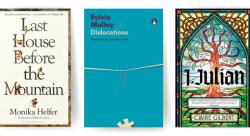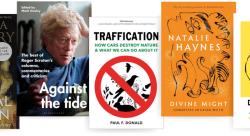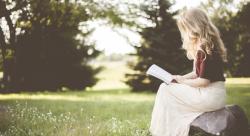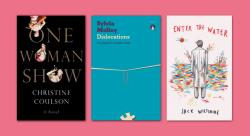
OUT NOW
THESE SILENT MANSIONS: A LIFE ON GRAVEYARDS by Jean Sprackland (Jonathan Cape, £16.99)
This gentle journey around England’s graveyards is anything but morbid. Jean Sprackland, who is also an award-winning poet, is less interested in death than in the stories that the departed have left behind: the lives and deeds remembered in stone and the way that churchyards help us situate ourselves in time and space.
Her odyssey begins in Stoke Newington with the tale of one Elizabeth Pickett, who died in 1781 when her clothes caught fire – a tragic fate that the sensationalist press pounced upon gleefully. In Ilfracombe a local historian tells Sprackland how the wreck of a slave ship in 1796 still inspires controversy. And in Norwich she finds the monument of John Barker, steam circus proprietor, who died in 1897 but whose amusements continue to tour the country.
Naturally, Sprackland reflects on her own mortality, but even when surrounded by death she is drawn to life. She is a keen observer of yew trees; the holly blue butterflies that favour graveyards, and ‘nostoc’, an algae that resurrects itself after rain. One of the best chapters is devoted to lichen: ‘This one like candlewax thrown across a table by a draft, this one like spilt engine oil on a garage forecourt.’ Wise, compassionate and involving.
Stephanie Cross
CLICK TO BUY
House of Trelawney by Hannah Rothschild (Bloomsbury, £16.99)
With echoes of Evelyn Waugh and Nancy Mitford, although not as crisp, this is a highly entertaining, lively and mildly satirical family saga of the impoverished aristocratic Trelawney family as they struggle to survive the financial crash of 2008 and shore up their crumbling 800-year-old castle in South Cornwall, which ‘has a room for every day of the year’, ‘miles of freezing corridors’ and ‘bad plumbing.’
The narrative moves between the hypnotically beautiful Cornish coast and the skyscraper soullessness of the City of London.
At the heart of the story is the relationship between three women: dependable dogsbody Jane, the 24th Earl’s daughter-in-law, battling to keep the castle’s roof from falling in and feeding her family on cheap mince; Blaze, the brilliant but loveless financier; and vivacious Anastasia, former university friend of Jane and Blaze, who disappeared to marry an Indian maharaja 20 years before.
Now dying of dengue fever, Anastasia entrusts her only child, to the care of her two friends. Their lives will never be the same again. To add to the mayhem, eccentric great-aunt Tuffy, a leading entomologist, ‘moves into the butler’s apartment bringing plastic bags full of live hopping fleas’.
Deliciously dark and wickedly funny, with unconventional, sympathetically-drawn, mainly broke upper class characters, in beautiful settings. I laughed aloud.
Rebecca Wallersteiner
CLICK TO BUY
MOTHER'S DAY PICKS
THE MIRROR AND THE LIGHT by Hilary Mantel (Fourth Estate, £25)
The much-anticipated final instalment of the Wolf Hall trilogy opens with Anne Boleyn’s beheading – and its determined protagonist, Thomas Cromwell, heading nonchalantly for breakfast. This is historical fiction at its finest: a follow-up to two Booker Prize winners, Wolf Hall and Bring Up the Bodies. Impeccably researched but also vivid and immersive, with intriguing psychological close-ups.
CLICK TO BUY
THE PASTRY SCHOOL by Julie Jones (Kyle Books, £25)
No one is suggesting that all mothers should be domestic goddesses (mine never went near a kitchen, and I’ve survived), but if yours is a determined foodie, this new baking bible will go down a treat. It’s a guide to delicate, elegant sweet and savoury bakes that can actually be made by a real human being in a home kitchen. It is full of accessible, unfussy recipes that will have the maximum impact.
CLICK TO BUY
ON CHAPEL SANDS: MY MOTHER AND OTHER MISSING PERSONS by Laura Cumming (Chatto & Windus, £16.99)
Delving into a strange and hushed episode from her mother’s childhood, when she went missing for five days, Laura Cumming explores the secrets and lies of a Lincolnshire seaside community in the 1930s, her family history and its legacy, and her own search for origins and answers. An atmospheric and acutely observed blend of mystery and memoir.
CLICK TO BUY
WHERE ARCHITECTS SLEEP: THE MOST STYLISH HOTELS IN THE WORLD by Sarah Miller (Phaidon, £16.95)
Who better than the founding editor-in-chief of Condé Nast Traveller UK to pick out truly exceptional hotels? Here she draws on architects’ feedback on their favourite places to stay, from all-out luxury to eco-conscious boltholes and stylish stays on a budget. Perfect for chic globe-trotting mothers: go one better and book her a stay to go with it.
CLICK TO BUY

OUR TOP PICK
DRESSED FOR WAR: The Story of Vogue Editor Audrey Withers, From the Blitz to the Swinging Sixties by Julie Summers (Simon & Schuster, £20)
Lay aside your preconceptions about fashion magazine editors: this is a story of graft and grit, of flair in the face of austerity, and one woman’s incredible balancing act, juggling conflicting personalities, air raids and paper shortages to produce a magazine with its finger on the pulse. Then, as now, Vogue was about so much more than frocks: this compelling biography shows how, under Wither’s tenure, it became a powerful emblem of British resilience.
After Oxford and a stint at a bookseller, Withers landed a job at Vogue and rose to become a defining influence in shaping British Vogue (or Brogue, as it was knowns), as distinct from the American mothership. She had the dream job, but also built a dream team: photographers Lee Miller and Cecil Beaton were regular contributors, with Miller also writing groundbreaking articles from the front line. During the Blitz staff would scuttle to the cellar when the building came under attack.
With her understated suits in navy or grey, her quietly assertive managerial style and knack for nurturing talent, Withers was a far cry from the exhuberances of today’s front row and The Devil Wears Prada (no withering put-downs from Withers). She is aptly likened to the conductor of an orchestra, drawing together disparate elements (read big talents with egos to match) into a perfect, sublime harmony.
Julie Summers paints an evocative picture of wartime London and occupied France, highlighting the role of women’s magazines in maintaining morale and disseminating government’s messages. Like her subject, she marshalls a vast array of voices, characters and stories into a harmonious, coherent whole. Essential reading for anyone with an interest in the history of magazine publishing, but with a much wider appeal, too.
Juanita Coulson
CLICK TO BUY
COFFEE TABLE BOOK
MAGNITUDE: CARTIER high jewellery by Francois Chaille and Capucine Juncker (Flammarion, £80)
Founded in Paris in 1847, Cartier is regarded as one of the most prestigious jewellers in the world, lauded for its intricate craftsmanship and designs. Dedicated to its new collection, this book is a fine showcase for the brand.
Mesmerising in its scale and scope, the Birth of the Universe collection is a dazzling triumph. The book’s pages are studded with exotic creations: a matrix opal weighing 77.27 carats; pendants of all shapes, sizes and colours; lapis lazuli, diamonds, rubies and emeralds. The tools and techniques used to create these masterpieces are also explored, giving the reader an in-depth insight into the iconic jewellery house. This is Cartier up close and personal.
Elizabeth Fitzherbert
CLICK TO BUY
ALSO ON THE SHELF
Love Notes From a German Building Site by Adrian Duncan (Head of Zeus, £16.99)
A man follows his girlfriend to Berlin and works on a building site; he keeps a notebook and has intense feelings about life. Duncan – Irish writer, artist and structural engineer – could not express himself more eloquently or masterfully in this stunning debut novel.
Elizabeth Fitzherbert
CLICK TO BUY







